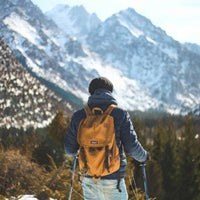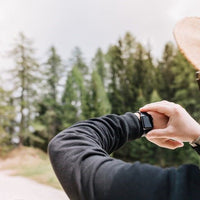
As the snow-capped mountains beckon and the excitement of your first ski trip builds, there's one crucial detail that can make or break your experience: keeping your feet warm.
Cold feet can easily turn a thrilling ski adventure into an uncomfortable ordeal, making it essential to equip yourself with the right strategies.
This is where we can help you. If you’re worried about dealing with cold feet during your ski trip, you’re in the right place! In this blog, we have laid out detailed explanations of each method to prevent cold feet before embarking on your first ski trip. Keep reading to learn all about them!
1. Invest in Quality Ski Socks
Begin with the foundation of warmth: your socks. Quality ski socks are engineered from advanced materials like merino wool or synthetic blends. These fabrics offer superior moisture-wicking properties, ensuring that perspiration is drawn away from your skin. Additionally, these socks provide insulation, trapping heat and keeping your feet comfortably warm. Invest in several pairs, allowing you to change them if they become damp during your skiing session.
2. Choose the Right Ski Boots
Your ski boots are more than just foot coverings; they are your direct interface with the snow. Ill-fitting boots can lead to restricted blood circulation, resulting in chilly toes. It’s crucial to visit a professional ski shop for a fitting session. Ski experts will measure your feet accurately and help you find boots that provide the right balance between snugness and comfort. Well-fitted boots ensure that your feet have enough room to move, promoting proper circulation while preventing unnecessary pressure points.

3. Layer Up
Layering isn’t just for clothing; it's a technique that applies to your socks, too. Start with a thin, moisture-wicking liner sock that fits snugly against your skin. This layer serves as the first defense against sweat, ensuring that moisture is swiftly moved away. Over the liner, wear a thicker insulating sock. Look for socks with extra cushioning around the toes and heels. The combination of these layers provides both insulation and moisture management, keeping your feet dry and warm.
4. Keep Your Feet Dry
Moisture is the nemesis of warmth, especially in cold environments. Before you embark on your ski adventure, make sure both your socks and boots are dry. Begin by thoroughly drying your feet, and then wear clean, dry socks. Additionally, ensure that the interior of your boots is dry. If your boots have liners, take them out to air dry. The absence of moisture inside your boots is crucial for retaining warmth.
5. Use Foot Warmers
Disposable foot warmers are a game-changer for skiers seeking extended warmth. These portable heat sources can be placed inside your boots, providing gentle, consistent warmth for several hours. Activated by air, foot warmers are safe and easy to use. They are particularly beneficial on extremely cold days or during long skiing sessions, offering an additional layer of warmth that can make a significant difference in your comfort level.

6. Warm-Up Your Boots
Cold boots can be a shock to your feet, literally. Warm them up before you put them on. Utilize boot dryers, which gently circulate warm air inside your boots, ensuring they are pleasantly warm when you slide your feet in. If you don’t have a boot dryer, place your boots near a heater or in a warm area for a few minutes. Warm boots provide an excellent starting point for keeping your feet warm throughout the day.
7. Mind Your Technique
Your skiing technique plays a significant role in maintaining warm feet. Proper skiing posture and weight distribution can enhance blood circulation in your feet. Avoid excessive pressure on your toes, as it can impede blood flow, leading to discomfort and coldness. Instead, focus on a balanced posture, ensuring your weight is evenly distributed across both feet. Proper skiing technique encourages healthy blood circulation, contributing to warm and comfortable feet.
8. Stay Active
Physical activity generates body heat, and skiing is no exception. While on the slopes, keep moving. Skiing involves constant motion, which helps generate warmth within your body. Active muscles and increased blood circulation are your allies in combating the cold. Avoid prolonged breaks; however, if you do stop, engage in gentle movements. Wiggle your toes, move your feet, and flex your ankles. These actions promote blood circulation, ensuring your feet remain warm and comfortable.

9. Protect Your Feet from Snow
Snow can find its way into your boots, leading to cold and damp feet. Prevent this by ensuring your pants are securely tucked into your boots. Additionally, consider using gaiters – protective coverings that seal the area between your boots and pants. Gaiters act as barriers, preventing snow from entering your boots. Dry, snow-free feet are warm feet.
10. Know When to Take a Break
Despite your best efforts, your feet might still feel cold, especially in harsh weather conditions. It’s essential to recognize the signs of cold feet and take appropriate action. If you notice persistent coldness or numbness, it's time to take a break. Head to a warm lodge or indoor area, remove your boots and allow your feet to warm up naturally. Gently wiggle your toes and massage your feet to encourage blood circulation. Ignoring the cold can lead to more severe issues like frostbite, so don’t hesitate to pause and warm up your feet when needed.

11. Maintain Good Circulation
Proper circulation is key to warm feet. Avoid sitting with your legs crossed or sitting on your feet during breaks. These positions can restrict blood flow, making it harder for your feet to stay warm. Instead, sit with your feet flat on the ground, allowing for unimpeded circulation. Maintain good posture, ensuring your feet have ample space to breathe and stay warm.
12. Choose the Right Terrain
While it’s tempting to challenge yourself on difficult slopes, it’s essential to consider the conditions. Deep powder and wet snow can make skiing more strenuous, leading to increased perspiration. This moisture can make your feet damp, leading to coldness. Opt for well-groomed slopes with manageable snow conditions. Choosing the right terrain reduces the strain on your body, minimizing perspiration and ensuring your feet stay warm.

13. Stay Hydrated and Well-Nourished
Proper hydration and nutrition are essential components of staying warm. Drink plenty of water throughout the day, even in cold weather. Hydration supports blood circulation and body temperature regulation. Additionally, have regular meals to maintain your energy levels.
Consuming nutrient-rich foods provides your body with the necessary fuel to generate warmth. A well-hydrated and well-fed body is more capable of keeping extremities warm, including your feet. It’ll also keep you energized and help you power through the more difficult parts of your ski trip.
14. Check Your Bindings
Your ski bindings play a vital role in your skiing experience. Ill-adjusted bindings can lead to an uneven distribution of weight on your feet, causing discomfort and coldness. Regularly check your bindings to ensure they are correctly adjusted according to your skiing level, weight, and boot size. If you're unsure, seek professional assistance. Properly adjusted bindings not only enhance your skiing performance but also contribute to your overall comfort, including warm feet.
15. Practice Good Aftercare
After a thrilling day on the slopes, taking care of your feet is paramount. Start by removing your boots, allowing your feet to breathe and relax. Dry your boots thoroughly, ensuring there is no residual moisture. If your boots have liners, take them out and air them separately. Clean and dry your socks, preparing them for the next day. Proper aftercare ensures that your gear is in excellent condition for another day of skiing. It also promotes foot hygiene, preventing issues like athlete’s foot, which can exacerbate coldness.

In conclusion, preventing cold feet during your first ski trip is not just about wearing thick socks and warm boots. It’s a holistic approach that involves proper gear, smart techniques, and awareness of your body's signals. By following these comprehensive methods, you can ensure that your feet remain warm and comfortable, allowing you to focus on the sheer joy of skiing.
Looking for Quality Gear to Take on Your Skip Trip? Choose Light Hiking Gear
Embarking on a ski trip? Ensure you stay warm and comfortable with high-quality, lightweight hiking gear from Light Hiking Gear. Our extensive range of ultralight backpacks and hiking gear can help you carry all that you need to stay warm during the trip.
Don’t let cold feet hamper your adventure—gear up with Light Hiking Gear today. Visit our website to explore our collection of comfortable hiking backpacks, dynamic daypacks, light camping gear, and more. Stay warm, stay comfortable, and enjoy every exhilarating moment on the slopes.
Contact us for expert recommendations and personalized assistance. Reach out to us for more information.




0 comments